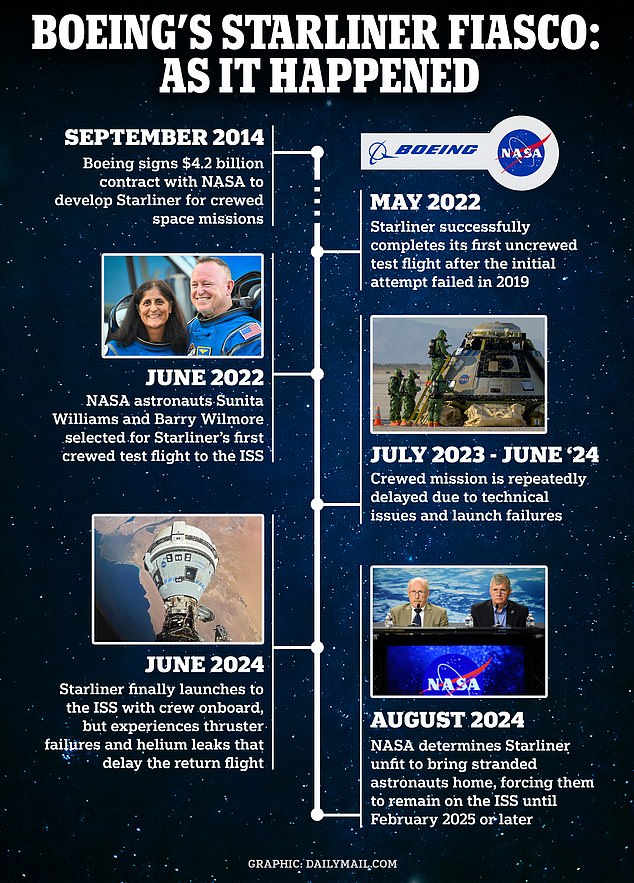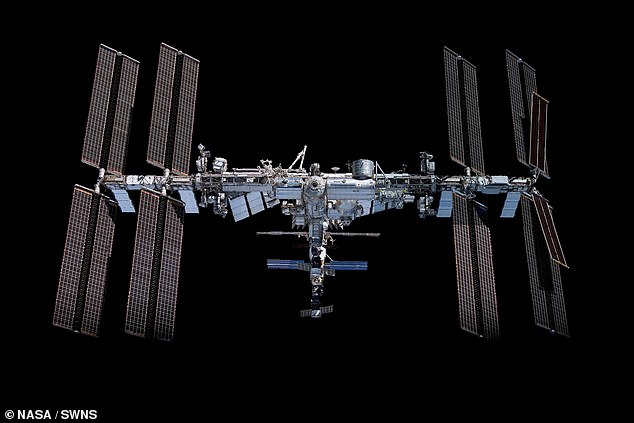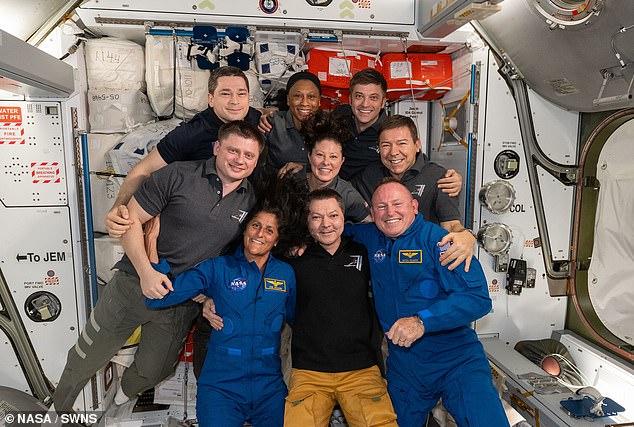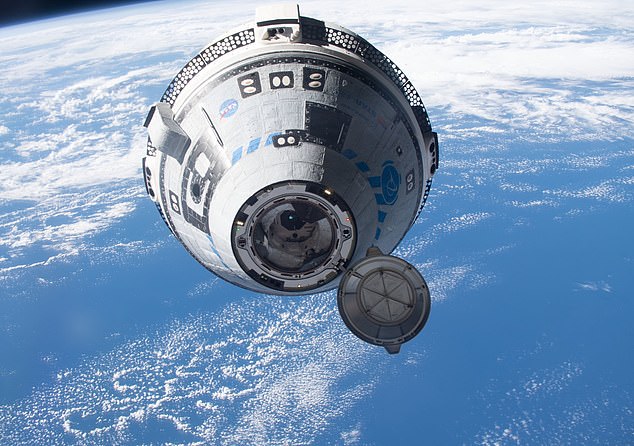Boeing’s malfunctioning Starliner spacecraft will finally begin its journey home today after spending three months docked to the International Space Station (ISS).
But experts have expressed concern about the slim chance that Starliner could malfunction again and potentially crash into the ISS.
“There is an extremely small chance that if all the boosters fail, Starliner could impact the ISS,” former US military space system commander Rudy Ridolfi told DailyMail.com.
“This will be like NASCAR for NASA, some will watch it just for the accident,” Ridolfi added.
Starliner’s technical problems, including thruster failures, have left its crew stranded on the ISS for the past three months.
Starliner will attempt to autonomously undock from the ISS today. Experts say there is a small chance that problems with the thrusters could cause it to crash into the space station.
NASA officials decided it was too risky to bring astronauts Sunita Williams and Barry Wilmore home on the malfunctioning spacecraft. They will remain on the International Space Station until next year, so Starliner will return to Earth today without a crew.
Shortly after 6 p.m. ET today, Starliner will autonomously undock from the ISS and then begin a six-hour flight back to Earth.
The spacecraft launched on June 5 and carried Williams and Wilmore to the ISS.
When the spacecraft arrived at the ISS, five of the 28 thrusters in its reaction control system had failed.
As a result, Starliner’s first attempt to dock with the space station was cancelled. But eventually, the spacecraft successfully docked and Williams and Wilmore safely boarded the ISS.
As to whether these propulsion issues have been resolved, “I would say no,” Harvard University astronomer and astrophysicist Jonathan McDowell told DailyMail.com.
While NASA and Boeing have identified overheating as a likely source of the problems, “they still don’t fully understand why the thrusters behave the way they do, and that means they can’t say for sure that they won’t malfunction again,” he said.
“That said, I hope that tonight everything goes well,” he continued. But in the very unlikely worst-case scenario, problems with the thrusters during undocking could result in Starliner colliding with the ISS.
If one of the thrusters doesn’t stop firing on command, for example, “it could push Starliner into a collision with some other part of the space station,” he said.

A complete timeline of Boeing’s Starliner program, from the announcement of its mass outreach to the incident that left two astronauts stranded aboard the ISS.
Accidents like this have happened before. In 1997, a Russian space station was damaged when a cargo ship slipped out of its docking port and crashed into one of the station’s modules.
The collision tore a hole in the space station “and the astronauts had to rush to close the hatches on that module before all the air left the space station,” McDowell said.
“It was very, very scary. That’s what you want to avoid,” he added.
Additionally, if more than a certain number of boosters fail, there’s a chance Starliner could get caught drifting toward the ISS and eventually crash, McDowell said previously. Business information.
“That could happen, but it would have to be very specific cases where it failed,” Ridolfi wrote in a statement sent to DailyMail.com.
“There are five ‘sets’ of thrusters and if they can still turn the spacecraft, those thruster sets can replace the ones that are out of service,” he continued.
If thruster failures cause Starliner to enter a collision course with the ISS, the crash will not happen immediately, Ridolfi said.
That’s because although the two objects will be close to each other, they will be in slightly different orbits, he explained.
“The US Space Force will be doing what’s called ‘conjunction analysis’ to show when the two objects might collide,” he said, adding that it could become an issue every 90 minutes or so as each object completes an orbit.
But the ISS also has its own thrusters that it can use to avoid a collision, which it does several times a year, Ridolfi said.
“It is difficult to move the ISS, mainly because it is a pig and moves very slowly,” he added.

The ISS is equipped with its own thrusters that it can use to avoid a collision, and it does so several times a year.
Additionally, mission control will be “watching like a hawk, so the moment any of the thrusters start to misbehave, they’ll shut it down and take over with a backup thruster,” McDowell said.
But even if Starliner manages to successfully undock from the ISS, it will still not be out of danger. After undocking, the spacecraft will have to re-enter the Earth’s atmosphere.
“At that point, you need the thrusters to be working properly, because they’re what’s steering the spacecraft as it fires its main engines, and it’s important that the main engines fire in the right direction,” McDowell said.
“The worst-case scenario is that you lose the propulsion system entirely, for example, and you can’t steer the spacecraft while it’s doing the deorbit burn,” he added.
In that case, the Starliner capsule would re-enter the atmosphere at the wrong angle and speed, causing it to burn up or become temporarily stranded in orbit before re-entering uncontrolled orbit some time later, he explained.
The problem with an uncontrolled burn during deorbit is that Starliner has a heat shield that helps it survive reentry. So, “we could imagine some chunks of this thing surviving to the surface,” McDowell said.

Problems with Starliner’s thrusters likely played a role in NASA’s decision not to bring astronauts Sunita Williams (front left) and Barry Wilmore (front right) home on the spacecraft.
“And if you’re really unlucky, that could happen somewhere populated. And it could be a repeat of the incident we had earlier this year, when a poor guy lost pieces of a spaceship on the roof of his house,” he continued.
But this scenario is highly unlikely. McDowell believes it is more likely that problems with the thrusters will cause the Starliner to burn up over the Pacific Ocean rather than landing at the White Sands spaceport in New Mexico as planned.
In the event that Starliner’s thrusters fail during reentry, there is little mission control can do to resolve the problem, McDowell said.
If problems arise early on, mission control could shut everything down, keep Starliner in orbit for another day and try again tomorrow, he explained.
“But once you’re in full burn, if things start to go wrong, you’re already on a trajectory where you’re going to hit the atmosphere somehow. So you just have to hope that everything stays okay,” he said.
The risks associated with potential booster accidents during both Starliner’s undocking and reentry likely influenced NASA’s decision not to bring Williams and Wilmore home on the spacecraft.
The space agency announced its decision at a press conference on August 24.
Instead, Williams and Wilmore will remain on the ISS until at least February 2025, when SpaceX’s Crew Dragon spacecraft will return them to Earth.
In a separate press conference Wednesday, NASA officials said they have been working to mitigate any risks to the ISS during Starliner’s undocking, and that tests of the spacecraft’s thrusters showed they were working well.


